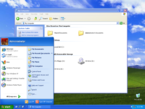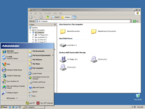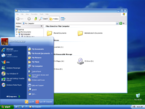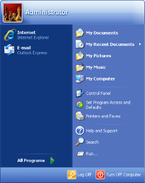 Windows XP is an operating system produced by Microsoft for use on personal computers, including home and business desktops, laptops and media centers. First released to computer manufacturers on August 24, 2001, it is the second most popular version of Windows, based on installed user base. The name "XP" is short for "eXPerience", highlighting the enhanced user experience.
Windows XP is an operating system produced by Microsoft for use on personal computers, including home and business desktops, laptops and media centers. First released to computer manufacturers on August 24, 2001, it is the second most popular version of Windows, based on installed user base. The name "XP" is short for "eXPerience", highlighting the enhanced user experience.User interface
 |  |
| Default Blue (Luna) | Windows Classic |
 |  |
| XP Media Center | The new start menu design in the "Royale" theme |
| The "task grouping" feature introduced in Windows XP showing both grouped and individual items | |
Windows XP featured a new task-based GUI (Graphical user interface). The Start menu and taskbar were updated and many visual effects were added, including:
- A translucent blue selection rectangle in Windows Explorer
- Drop shadows for icon labels on the desktop
- Task-based sidebars in Explorer windows ("common tasks")
- The ability to group the taskbar buttons of the windows of one application into one button, with a popup menu listing the window titles
- The ability to lock the taskbar to prevent accidental changes (Windows 2000 with Internet Explorer 6 installed had the ability to lock Windows Explorer and Internet Explorer toolbars, but not the taskbar)
- The highlighting of recently added programs on the Start menu
- Shadows under menus (Windows 2000 had shadows under mouse pointers, but not menus)
Windows XP analyzes the performance impact of visual effects and uses this to determine whether to enable them, so as to prevent the new functionality from consuming excessive additional processing overhead. Users can further customize these settings. Some effects, such as alpha compositing (transparency and fading), are handled entirely by many newer video cards. However, if the video card is not capable of hardware alpha blending, performance can be substantially degraded, and Microsoft recommends the feature should be turned off manually. Windows XP added the ability for Windows to use "Visual Styles" to change the appearance of the user interface. However, visual styles must be cryptographically signed by Microsoft to run. Luna is the name of the new visual style that is provided with Windows XP, and is enabled by default for machines with more than 64 MiB of RAM. Luna refers only to one particular visual style, not to all of the new user interface features of Windows XP as a whole. Some users "patch" the uxtheme.dll file that restricts the ability to use visual styles, created by the general public or the user, on Windows XP. In addition to the included Windows XP themes, there is one previously unreleased theme with a dark blue taskbar and window bars similar to Windows Vista titled "Royale Noir" available as unofficial download. Microsoft officially released a modified version of this theme as the "Zune" theme, to celebrate the launch of its Zune portable media player in November 2006. The differences are only visual with a new glassy look along with a black taskbar instead of dark blue and an orange start button instead of green. Additionally, the Media Center "Royale" theme, which was included in the Media Center editions, is also available to download for use on all Windows XP editions.
The default wallpaper, Bliss, is a photo of a landscape in the Napa Valley outside Napa, California, with rolling green hills and a blue sky with stratocumulus and cirrus clouds.
The "classic" interface from Windows 9x and 2000 can be used instead if preferred. Several third party utilities exist that provide hundreds of different visual styles.
New and updated features
Windows XP introduced several new features to the Windows line, including:
- GDI+ graphics subsystem and improved image management and viewing in the shell
- DirectX 8.1 upgradeable to DirectX 9.0c
- Start Menu and Taskbar improvements
- A number of new features in Windows Explorer including task panes, tiles and filmstrip views, improved sorting and grouping, searching by document categories, customizable infotips, built-in CD burning, AutoPlay, Simple File Sharing and WebDAV mini-redirector.
- Improved imaging features such as Windows Picture and Fax Viewer, improved image handling and thumbnail caching in Explorer
- A number of kernel enhancements and power management improvements
- Faster start-up, (due to improved Prefetch functions) logon, logoff, hibernation and application launch sequences.
- The ability to discard a newer device driver in favor of the previous one (known as driver rollback) should a driver upgrade not produce desirable results.
- Numerous improvements to increase the system reliability such as improved System Restore, Automated System Recovery, Windows Error Reporting and driver reliability.
- A new, arguably more user-friendly interface, including the framework for developing themes for the desktop environment and richer icons with alpha transparency
- Hardware support improvements such as USB 2.0, FireWire 800, Windows Image Acquisition, Media Transfer Protocol, DualView for multi-monitors and audio improvements.
- Fast user switching, which allows users to save the current state and open applications of their desktop and allows another user to log on without losing that information
- The ClearType font rendering mechanism, which is designed to improve text readability on liquid crystal display (LCD) and similar monitors, especially laptops.
- Remote Assistance and Remote Desktop features, which allow users to connect to a computer running Windows XP from across a network or the Internet and access their applications, files, printers, and devices or request help.
- New networking features including Windows Firewall, Internet Connection Sharing integration with UPnP, NAT traversal APIs, Quality of Service features, IPv6 and Teredo tunneling, Background Intelligent Transfer Service, extended fax features, network bridging, peer to peer networking, support for most DSL modems, IEEE 802.11 (Wi-Fi) connections with auto configuration and roaming, TAPI 3.1, Bluetooth and networking over FireWire.
- New security features such as Software Restriction Policies, Credential Manager, Encrypting File System improvements, improved certificate services, smart card and PKIsupport. Windows XP SP2 introduced Data Execution Prevention, Windows Security Center and Attachment Manager.
- Side-by-side assemblies and registration-free COM
- Improved media features in Windows Media format runtime, Windows Media Player, Windows Movie Maker, TV/video capture and playback technologies, Windows Media Encoder and introduction of Windows Media Center
- General improvements to international support such as more locales, languages and scripts, MUI support in Terminal Services, improved IMEs and National Language Support,Text Services Framework
- Handwriting recognition, speech recognition and digital ink support accessible through the Tablet PC Input Panel (TIP) in Windows XP Tablet PC Edition
- Numerous improvements to system administration tools such as Windows Installer, Windows Script Host, Disk Defragmenter, Windows Task Manager, Group Policy,CHKDSK, NTBackup, Microsoft Management Console, Shadow Copy, Registry Editor, Sysprep and WMI
- Improved application compatibility and shims compared to Windows 2000
- Updated accessories and games.
- Improvements to IntelliMirror features such as Offline Files, Roaming user profiles and Folder redirection.
Users in British schools observed the improved ease of use and advanced capabilities – comparing the former toRISC OS and Mac OS, and the latter to Unix.
Removed features
Some of the programs and features that were part of the previous versions of Windows did not make it to Windows XP. CD Player, DVD Player and Imaging for Windows are removed as Windows Picture and Fax Viewer, Windows Media Player and Windows shell takeover their duties. NetBEUI and NetDDE are deprecated and are not installed by default. DLC and AppleTalk network protocols are removed. Plug-and-play–incompatible communication devices (like modems and network interface cards) are no longer supported.
Service Pack 2 and Service Pack 3 also remove features from Windows XP but to a less noticeable extent. For instance, Program Manager and support for TCP half-openconnections are removed in Service Pack 2. Energy Star logo and the address bar on taskbar are removed in Service Pack 3.
The minimum hardware requirements for Windows XP Professional include:
- Pentium 233-megahertz (MHz) processor or faster (300 MHz is recommended)
- At least 64 megabytes (MB) of RAM (128 MB is recommended)
- At least 1.5 gigabytes (GB) of available space on the hard disk
- CD-ROM or DVD-ROM drive
- Keyboard and a Microsoft Mouse or some other compatible pointing device
- Video adapter and monitor with Super VGA (800 x 600) or higher resolution
- Sound card
- Speakers or headphones
- Extract it with Winrar
Burn It with Clone CD
Use These CD-Keys:
677TX-4QRXY-K3VCW-D8D39-4J4FY
GHVRK-D3PTV-MKHYM-KGH8K-XXTKX
V33G4-MK626-JXVW6-GDPH4-Y73X4
D2HHD-6TYYY-36J2V-T67PQ-M6XRM
NOTE: THIS IS A TORRENT FILE YOU MUST HAVE uTORRENT INSTALLED
IN YOUR SYSTEM.



No comments:
Post a Comment